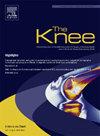后稳定全膝关节置换术中,髁间切迹周围的后囊膜释放可增加伸展间隙而不影响屈曲间隙。
IF 1.6
4区 医学
Q3 ORTHOPEDICS
引用次数: 0
摘要
背景:在后路稳定(PS)全膝关节置换术(TKA)中,放置股骨试验假体后,关节伸展间隙减小,导致伸展和屈曲间隙不平衡。先前的研究表明,髁间切迹周围囊膜的释放可以扩大髁间延伸间隙;然而,其对屈曲间隙的影响尚不清楚。本研究评估了髁间切迹周围囊膜释放对伸展和屈曲间隙的影响。方法:本研究纳入100例PS-TKA患者,术中进行囊膜释放以避免屈曲挛缩并平衡伸屈间隙。我们使用FuZion™张量仪通过股骨试验测量间隙和倾斜角度,施加40磅的关节牵引力。评估胶囊释放前后间隙和倾斜角度的差异。结果:囊膜释放前后的平均中心构件间隙(CG)为10.0 mm,伸展时为12.5 mm (P)。结论:本研究证实,在PS-TKA中,髁间切迹周围的囊膜释放显著增大伸展构件间隙,而对屈曲构件间隙的影响不显著。本文章由计算机程序翻译,如有差异,请以英文原文为准。
Posterior capsular release around the intercondylar notch increases extension gap without affecting flexion gap in posterior-stabilized total knee arthroplasty
Background
In posterior-stabilized (PS) total knee arthroplasty (TKA), joint extension gap decreases after placement of a femoral trial component which causes imbalance between the extension and flexion gaps. Previous studies have demonstrated that capsular release around the intercondylar notch can enlarge the extension gap; however, its impact on the flexion gap is unknown. This study assessed the effect of capsular release around the intercondylar notch on both extension and flexion gaps.
Methods
This study included 100 patients who underwent PS-TKA, and capsular release was performed intraoperatively to avoid flexion contracture and to balance the extension–flexion gap. We measured the gap and tilting angle with a femoral trial using FuZion™ tensor, applying a joint distraction force of 40 lbs. The differences in gap and tilting angle were assessed before and after capsular release.
Results
The mean center component gap (CG) before and after capsular release was 10.0 mm and 12.5 mm in extension (P < 0.001), 14.1 mm and 14.2 mm in flexion (P = 0.58), respectively. Calculated medial CG before and after capsular release was 9.2 mm and 11.4 mm in extension (P < 0.001), 12.6 mm and 12.7 mm in flexion (P = 0.20), respectively. The average medial CG difference significantly decreased from 3.4 mm to 1.3 mm after release.
Conclusion
This study confirmed that capsular release around the intercondylar notch significantly enlarges the extension component gap, while having an insignificant effect on the flexion component gap in PS-TKA.
求助全文
通过发布文献求助,成功后即可免费获取论文全文。
去求助
来源期刊

Knee
医学-外科
CiteScore
3.80
自引率
5.30%
发文量
171
审稿时长
6 months
期刊介绍:
The Knee is an international journal publishing studies on the clinical treatment and fundamental biomechanical characteristics of this joint. The aim of the journal is to provide a vehicle relevant to surgeons, biomedical engineers, imaging specialists, materials scientists, rehabilitation personnel and all those with an interest in the knee.
The topics covered include, but are not limited to:
• Anatomy, physiology, morphology and biochemistry;
• Biomechanical studies;
• Advances in the development of prosthetic, orthotic and augmentation devices;
• Imaging and diagnostic techniques;
• Pathology;
• Trauma;
• Surgery;
• Rehabilitation.
 求助内容:
求助内容: 应助结果提醒方式:
应助结果提醒方式:


